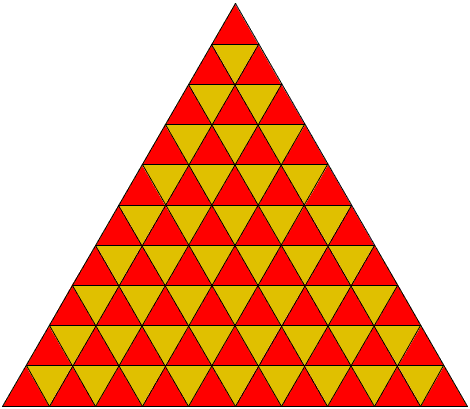100 Grasshoppers on a Triangular Board
|Contact| |Front page| |Contents| |Arithmetic|
Copyright © 1996-2018 Alexander BogomolnySolution

The board is naturally colored into two colors so that the neighboring cells are colored differently. Let the colors be red and brown and label the grasshoppers by the color of their cells. Convince yourself that there are 55 red and 45 brown cells. In one hop, the brown grasshoppers move to the red cells thus emptying 55 cells. On the same hop, the brown grasshoppers move to the red cells thus filling at most 45 red cells. Inevitably, at least 10 red cells will remain empty.
The next time the grasshoppers move, they can move into their original cells, thus filling all of them. The situation will return to the original one, while the argument will apply to every odd hop. Perhaps there may happen a greater mix-up of the red and brown hoppers, but the best that may be claimed is that after every odd hop, there are at least 10 empty cells.
In general, there are n(n+1)/2 red cells and n(n-1)/2 brown cells. The difference being
The specific number of hops (9) is nothing but a red herring.
Note: the discrepancy between the two kinds of cells in the general partition of a triangle into smaller ones, shows up in a different problem.
What Is Red Herring
- On the Difference of Areas
- Area of the Union of Two Squares
- Circle through the Incenter
- Circle through the Incenter And Antiparallels
- Circle through the Circumcenter
- Inequality with Logarithms
- Breaking Chocolate Bars
- Circles through the Orthocenter
- 100 Grasshoppers on a Triangular Board
- Simultaneous Diameters in Concurrent Circles
- An Inequality from the 2015 Romanian TST
- Schur's Inequality
- Further Properties of Peculiar Circles
- Inequality with Csc And Sin
- Area Inequality in Trapezoid
- Triangles on HO
- From Angle Bisector to 120 degrees Angle
- A Case of Divergence
- An Inequality for the Cevians through Spieker Point via Brocard Angle
- An Inequality In Triangle and Without
- Problem 3 from the EGMO2017
- Mickey Might Be a Red Herring in the Mickey Mouse Theorem
- A Cyclic Inequality from the 6th IMO, 1964
- Three Complex Numbers Satisfy Fermat's Identity For Prime Powers
- Probability of Random Lines Crossing
- Planting Trees in a Row
- Two Colors - Three Points
|Contact| |Front page| |Contents| |Arithmetic|
Copyright © 1996-2018 Alexander Bogomolny71535029
